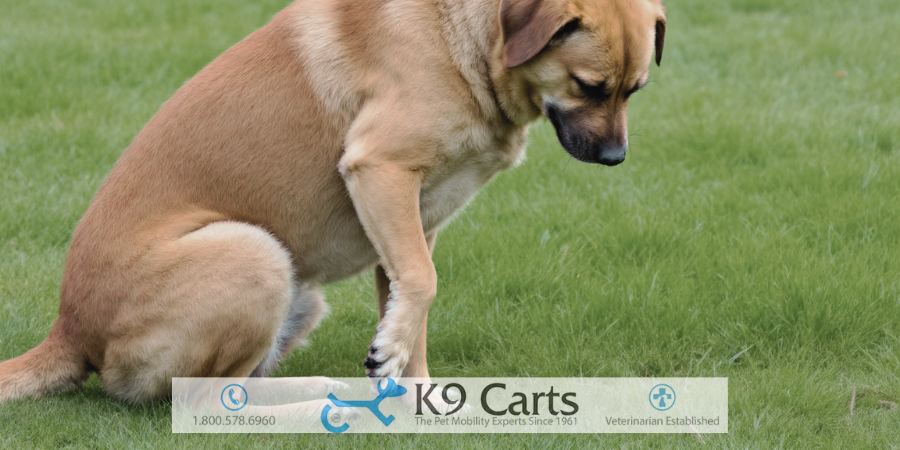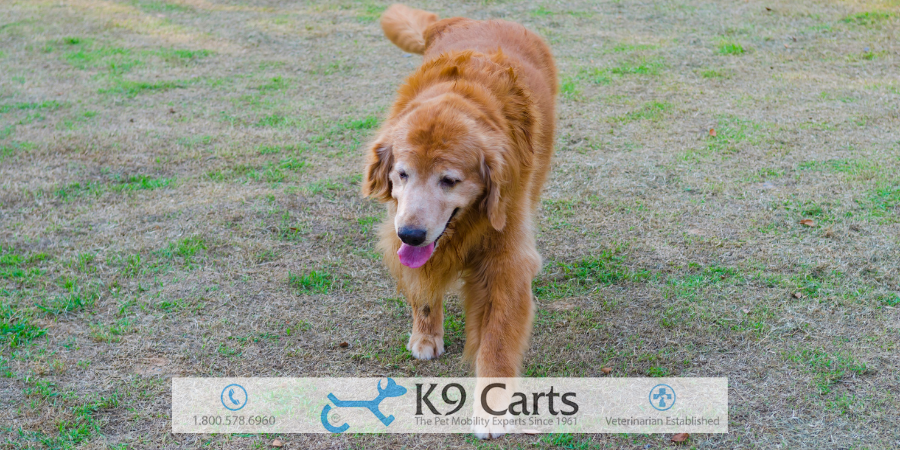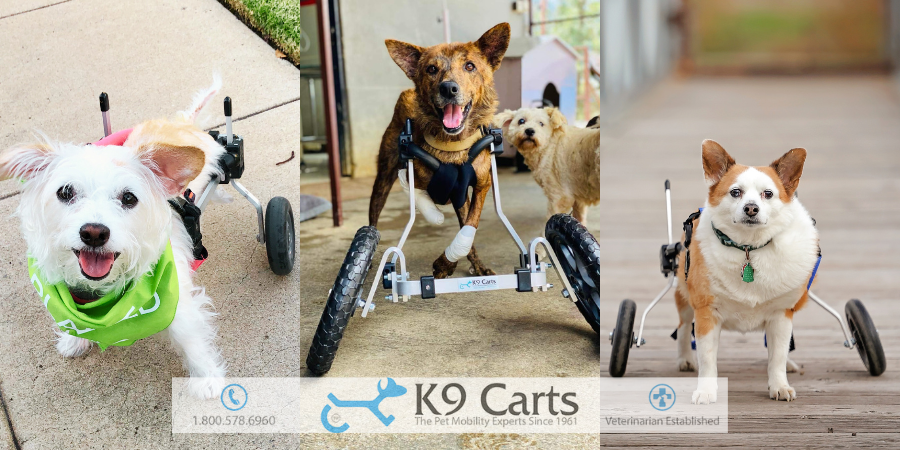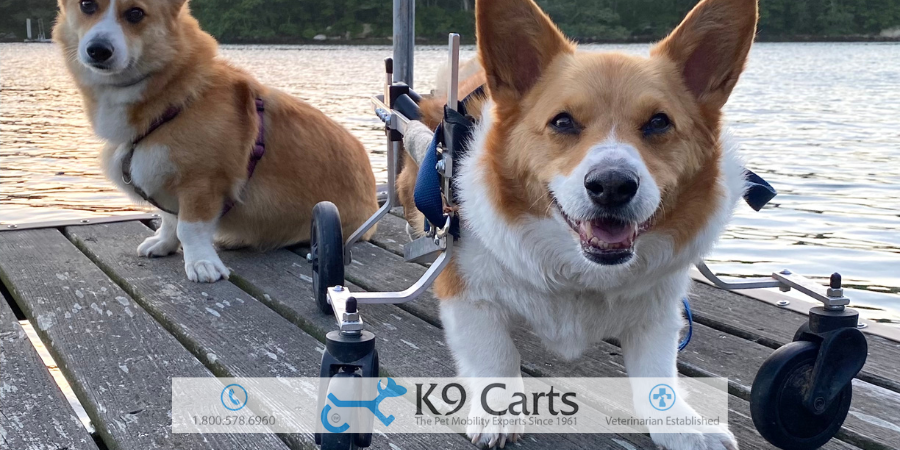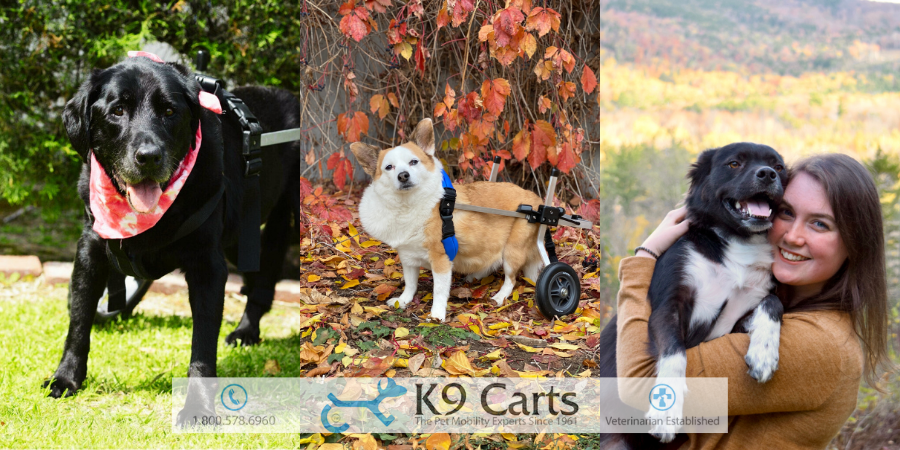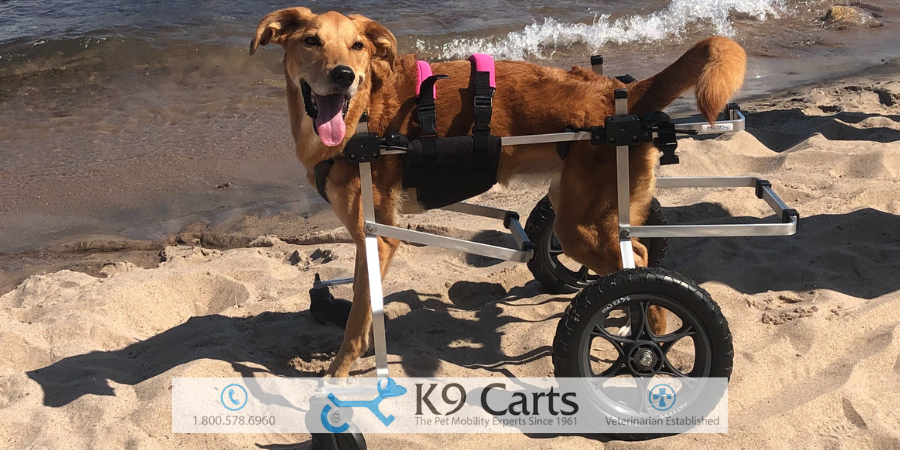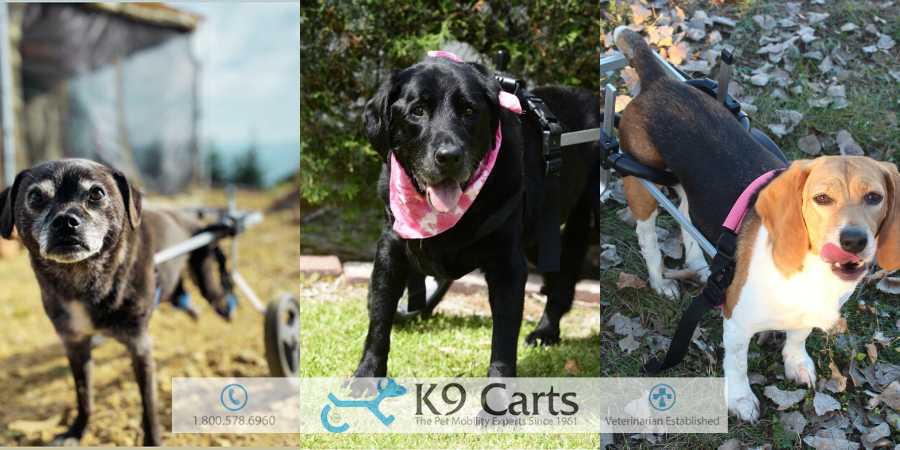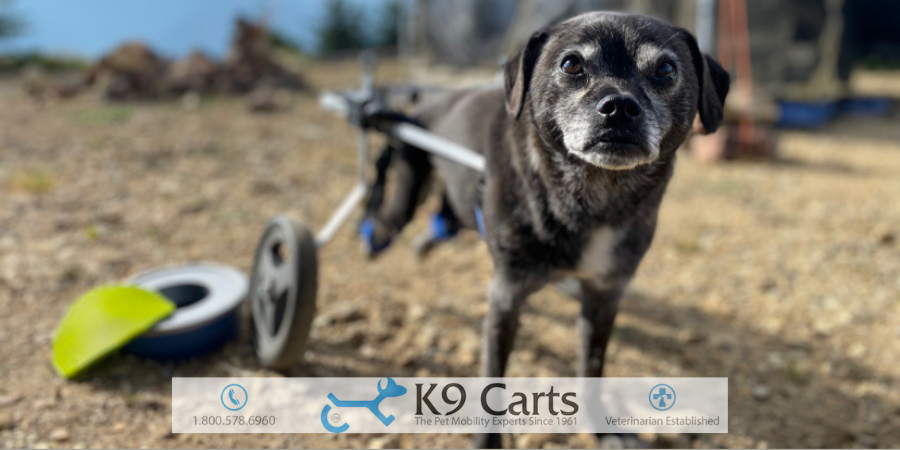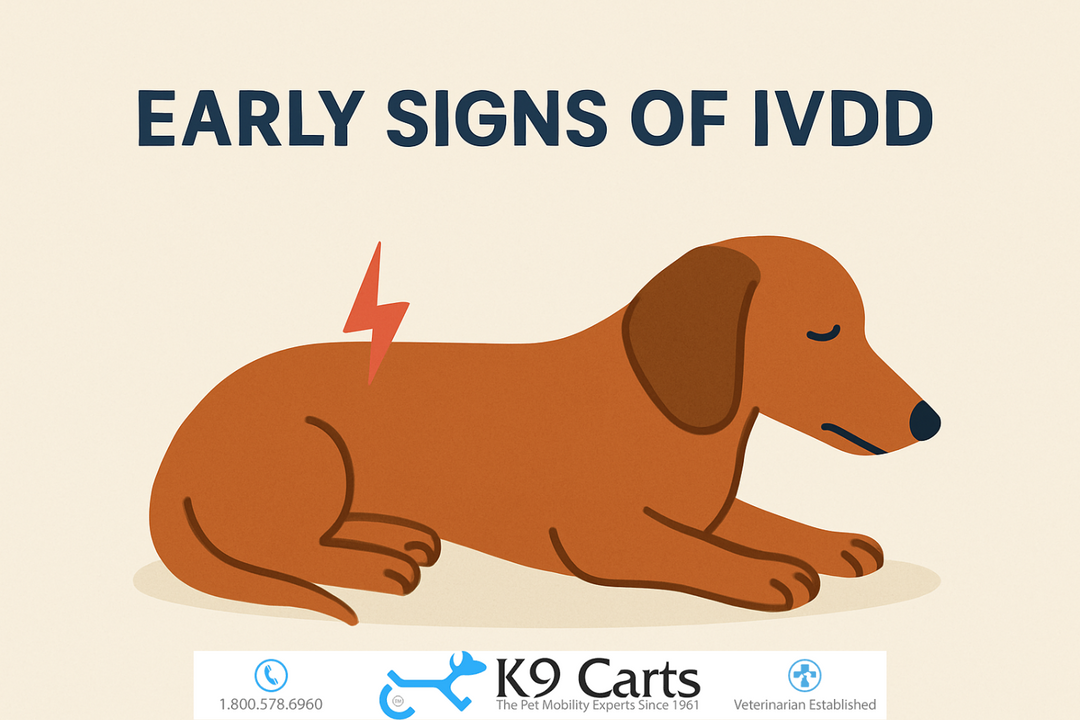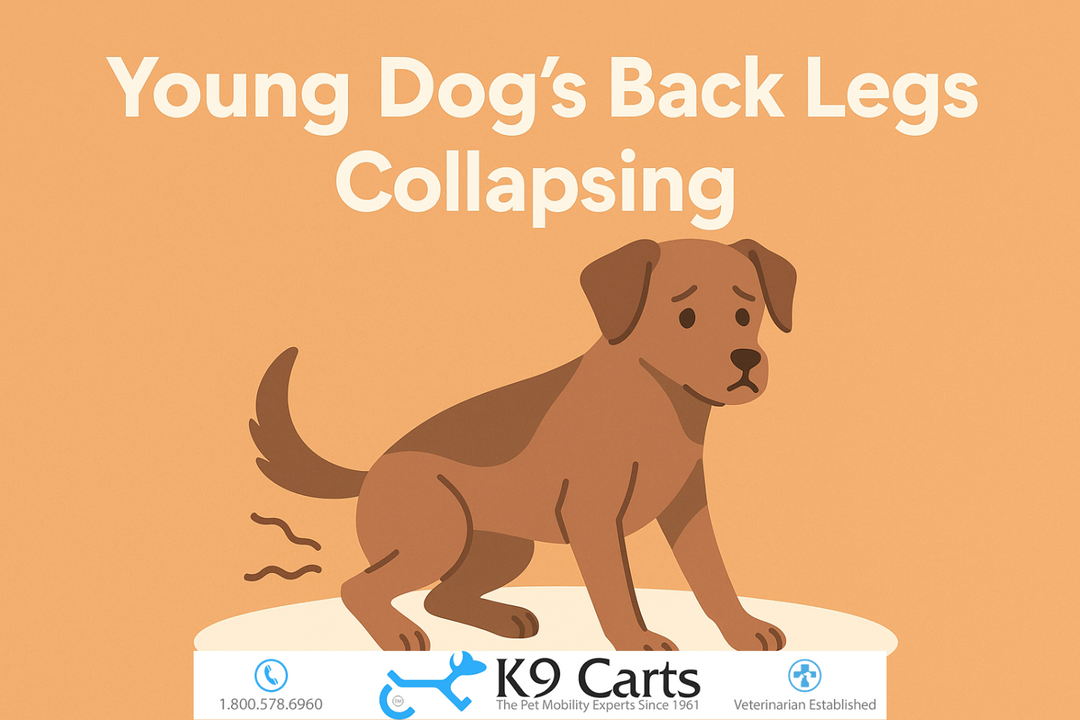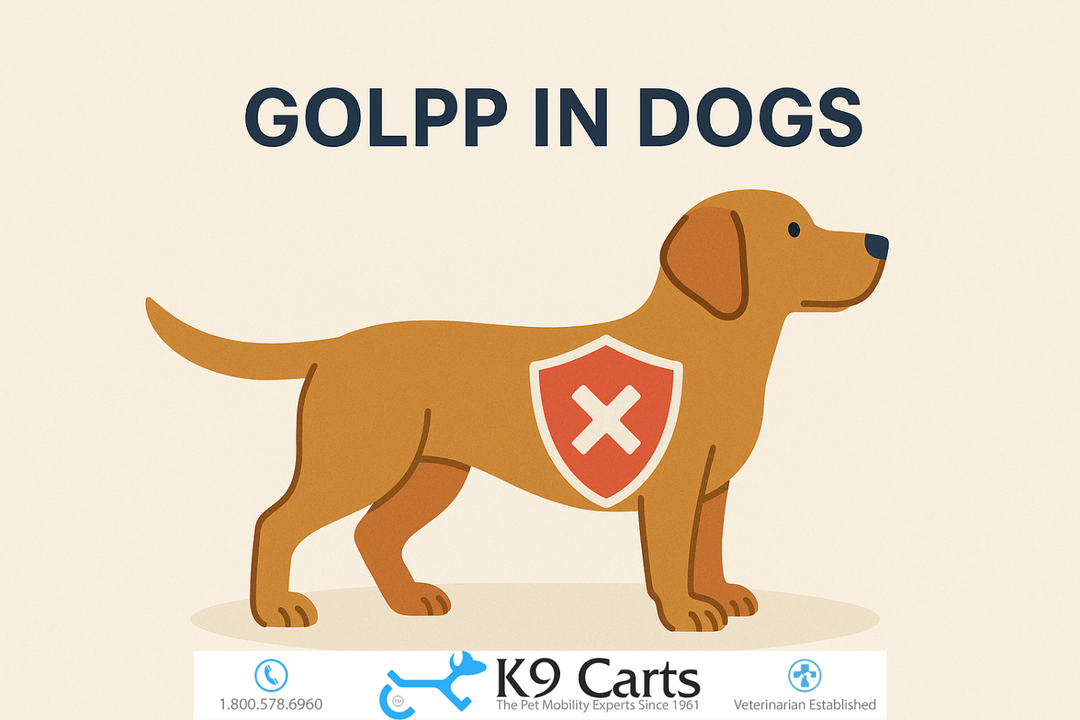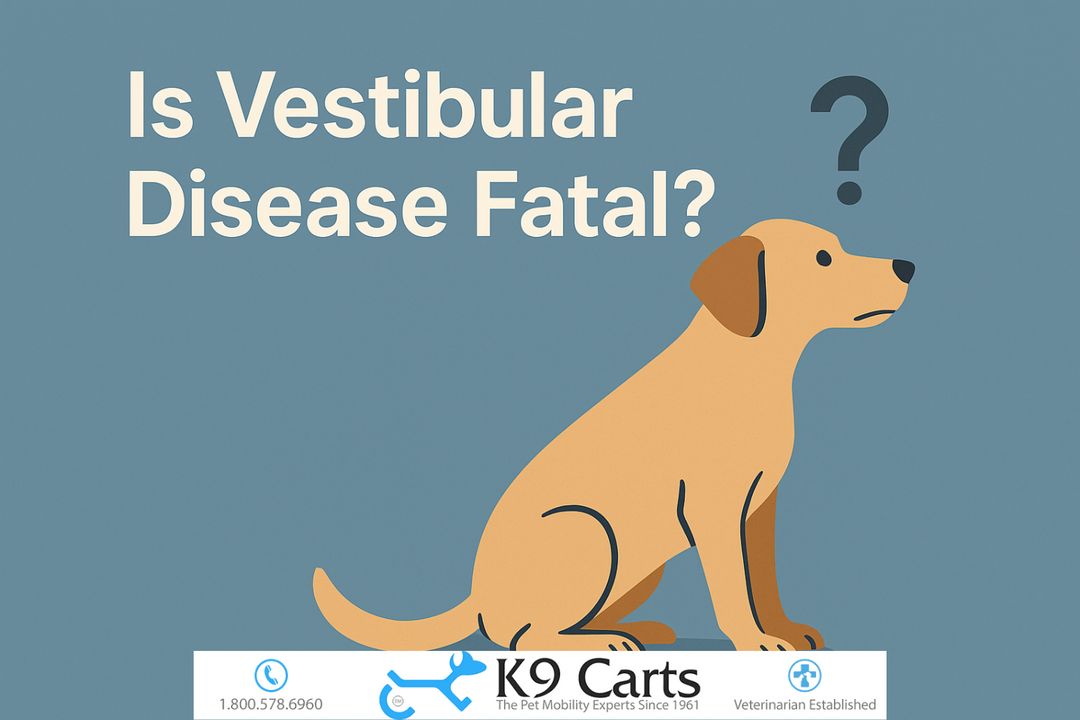Resources
Dog Not Putting Weight on Its Front Leg: Causes, Symptoms, Treatment, and Care
When a dog suddenly stops putting weight on its front leg, it is a cause for concern. This behavior can indicate a range of issues, from minor sprains to serious conditions like fractures or nerve damage. Understanding the possible causes, recognizing symptoms, and knowing how to respond can make a significant difference in your dog’s comfort and recovery.
This guide covers the potential reasons why a dog may not be using its front leg, how to assess the severity of the issue, treatment options, and ways to support your pet’s recovery, including mobility solutions like custom-built wheelchairs.
Common Causes of Front Leg Lameness in Dogs
1. Injuries and Trauma
Dogs are active animals that often jump, run, and play at high speeds. Trauma-related injuries like sprains and fractures can result in front leg lameness.
Sprains and Strains: Overexertion, slipping, or sudden movements can stretch or tear tendons and ligaments.
Fractures and Dislocations: A fall, collision, or direct impact can break bones or dislocate joints.
Wounds or Foreign Objects: Cuts, punctures, or embedded objects in the paw can make weight-bearing painful.
2. Joint and Bone Conditions
As dogs age, or in certain breeds predisposed to orthopedic issues, chronic conditions may affect the front leg.
Arthritis: Degenerative joint disease can cause stiffness, inflammation, and pain, particularly in older dogs.
Elbow Dysplasia: Common in large breeds, this hereditary condition leads to joint instability and discomfort.
Osteosarcoma: A type of bone cancer that causes pain and lameness.
Panosteitis: Also known as "growing pains," this condition affects young, large-breed dogs.
3. Neurological Disorders
Problems with the nervous system can impact a dog's ability to use its front leg properly.
Nerve Damage: Trauma, compression, or degenerative conditions can lead to partial or complete limb dysfunction.
Brachial Plexus Avulsion: A severe injury that occurs when nerves in the shoulder area are stretched or torn.
Intervertebral Disc Disease (IVDD): A spinal condition that can cause weakness or paralysis in one or more limbs.
4. Infections and Inflammatory Conditions
Bacterial, viral, or autoimmune conditions can contribute to lameness.
Lyme Disease: A tick-borne infection that can lead to joint inflammation and shifting lameness.
Immune-Mediated Polyarthritis (IMPA): An autoimmune disorder that causes inflammation in multiple joints.
Abscesses: Infected wounds can lead to localized swelling and pain.
Recognizing Symptoms and Assessing Severity
Signs to Look For
Identifying the severity of your dog’s condition involves careful observation.
Limping or reluctance to use the leg
Swelling, bruising, or visible wounds
Pain response when touching the limb
Joint stiffness or reduced range of motion
Sudden yelping or signs of distress
Licking or biting at the affected area
When to See a Veterinarian
Some cases require immediate veterinary attention, while others can be managed at home. Seek professional help if:
The leg appears broken, deformed, or severely swollen.
Your dog refuses to move or shows signs of extreme pain.
The lameness persists for more than 48 hours.
There is an open wound, bleeding, or signs of infection.
Your dog has a history of joint disease or neurological issues.
Treatment Options for Front Leg Lameness
At-Home Care for Mild Cases
For minor sprains or strains, you can take simple steps to aid recovery.
Rest and Restriction: Limit movement and prevent excessive activity for a few days.
Cold and Warm Therapy: Use ice packs for the first 24–48 hours to reduce swelling, followed by warm compresses to promote healing.
Massage and Stretching: Gentle techniques can relieve muscle tension and improve circulation.
Paw Inspection: Check for cuts, swelling, or lodged debris that may be causing discomfort.
Veterinary Treatments
For more severe cases, professional medical intervention is necessary.
Pain Medication and Anti-Inflammatories: NSAIDs or other prescribed drugs can alleviate discomfort.
Physical Therapy and Rehabilitation: Hydrotherapy, laser therapy, and other modalities can enhance recovery.
Surgery: In cases of fractures, torn ligaments, or dislocations, surgical intervention may be required.
Orthopedic Braces or Splints: Supportive devices can stabilize the limb and promote healing.
Supporting Mobility and Long-Term Care
Preventing Further Injury
Once a dog recovers, taking precautions can help prevent re-injury.
Maintain a healthy weight to reduce joint strain.
Provide non-slip flooring to prevent falls.
Use ramps instead of stairs for senior dogs.
Keep nails trimmed to support proper foot positioning.
When a Dog Wheelchair Can Help
For dogs experiencing long-term front leg weakness or partial paralysis, mobility aids can greatly improve quality of life. K9 Carts offers custom-built wheelchairs that provide front-leg support while allowing dogs to stay active. These devices help:
Dogs with nerve damage or partial limb paralysis.
Pets recovering from surgery who need temporary assistance.
Senior dogs with severe arthritis or degenerative conditions.
A front-support wheelchair enables dogs to maintain independence while reducing strain on the healthy limbs. Properly fitted mobility aids ensure comfort and safety while preventing further injuries.
Giving Your Dog the Best Support
If your dog is not putting weight on its front leg, early intervention is key. Whether the issue is minor or serious, understanding the possible causes and taking the right steps can improve outcomes. Consulting a veterinarian, implementing treatment, and considering long-term support solutions like a custom wheelchair can make all the difference. By providing proper care and mobility assistance, you can ensure your dog stays happy and active for years to come.
Cat Suddenly Limping on Its Back Leg: Causes, Symptoms, Treatment, and Care
A cat suddenly limping on its back leg can be concerning. Cats are agile creatures, and any change in their mobility can indicate an underlying issue. Limping can result from injury, illness, or chronic conditions. Understanding the possible causes, symptoms, and treatment options can help pet owners take the right steps to ensure their cat's well-being.
Common Causes of Limping in a Cat’s Back Leg
Injuries and Trauma
Cats are known for their climbing and jumping abilities, but accidents happen. Some of the most common injuries leading to sudden limping include:
Sprains and Strains: Overstretching a muscle or ligament can cause temporary limping.
Fractures and Dislocations: A fall, car accident, or fight can lead to broken bones or joint dislocations.
Bite Wounds or Abscesses: Fights with other animals can lead to deep puncture wounds, which can become infected and cause swelling.
Toenail Injuries: A torn or broken toenail can cause pain and limping.
Arthritis and Joint Issues
Arthritis is more common in older cats but can develop at any age due to injury or genetic factors. Signs of arthritis include:
Stiffness in movement
Reluctance to jump or climb
Increased sleeping or resting periods
Neurological Disorders
Certain neurological conditions can cause a cat to limp, including:
Nerve Damage: Trauma or illness affecting the nerves can lead to weakness in the leg.
Feline Diabetic Neuropathy: Cats with diabetes may develop nerve issues, resulting in an abnormal gait.
Spinal Issues: Herniated discs or spinal cord injuries can affect hind leg movement.
Paw and Pad Problems
Pain in the paw or pad can also cause limping. Possible causes include:
Foreign Objects: Thorns, glass, or other debris stuck in the paw
Burns or Irritations: Hot pavement or chemicals can damage paw pads
Fungal or Bacterial Infections: Paw infections can cause swelling and pain
Bone and Muscle Conditions
Some conditions that affect the bones or muscles can lead to limping, including:
Hip Dysplasia: A genetic disorder that leads to improper hip joint formation.
Osteosarcoma: A type of bone cancer that can cause pain and lameness.
Luxating Patella: A condition where the kneecap slips out of place.
Infections and Systemic Diseases
Certain diseases and infections can lead to limping, including:
Lyme Disease: Although rare in cats, tick-borne diseases can cause joint pain.
Feline Calicivirus: A respiratory virus that can lead to limping due to joint inflammation.
Autoimmune Disorders: Conditions where the immune system attacks the joints and muscles.
Recognizing Symptoms That Require Immediate Attention
Not all cases of limping require emergency care, but some signs indicate a need for immediate veterinary attention:
Severe pain or vocalization
Visible swelling or an open wound
Inability to bear weight on the leg
Dragging the leg or complete paralysis
Fever or lethargy accompanying the limping
Diagnosing the Cause of Limping
A veterinarian will perform a physical exam and may use additional tests to determine the cause:
X-rays: To identify fractures, arthritis, or joint issues.
Blood Tests: To check for infections, inflammation, or systemic diseases.
Ultrasound or MRI: For soft tissue and nerve evaluations.
Joint Fluid Analysis: To detect infections or autoimmune disorders.
Treatment Options for a Limping Cat
At-Home Care for Mild Cases
If the limping is mild and there is no visible injury, some home remedies can help:
Rest and Restricted Movement: Keep the cat in a confined area to avoid excessive activity.
Cold Compress: Apply a cold pack wrapped in a towel to reduce swelling (if an injury is suspected).
Paw Inspection: Check for foreign objects, cuts, or swelling.
Soft Bedding: Provide a comfortable area to reduce joint strain.
Veterinary Treatment for More Severe Cases
Depending on the diagnosis, a vet may recommend:
Pain Management: Anti-inflammatory medications or painkillers.
Antibiotics or Antifungals: If an infection is present.
Surgery: For fractures, ligament tears, or severe joint issues.
Physical Therapy: To aid recovery and strengthen the affected limb.
Weight Management: For cats with arthritis or joint disorders.
Supporting a Cat’s Mobility with a Wheelchair
Some conditions may cause long-term mobility issues. In such cases, a custom-built cat wheelchair can provide support. These mobility aids help cats regain their independence and move comfortably, reducing strain on injured or weak legs. K9 Carts offers lightweight, veterinarian-designed wheelchairs tailored to a cat’s specific needs, ensuring a better quality of life.
How to Prevent Future Injuries and Mobility Issues
While some causes of limping are unavoidable, certain precautions can reduce the risk:
Regular Vet Check-Ups: Early detection of joint issues or diseases.
Indoor Safety Measures: Keep hazardous objects out of reach and provide stable surfaces for jumping.
Paw Care: Regularly check paws for injuries or foreign objects.
Weight Management: Maintain a healthy weight to prevent joint strain.
Exercise and Enrichment: Encourage gentle movement to keep muscles strong and joints healthy.
Helping Your Cat Stay Active and Comfortable
A limping cat may need extra care and attention. With proper treatment and support, many cats recover fully and return to their usual activities. If mobility challenges persist, assistive devices like custom-built wheelchairs can help them maintain an active lifestyle. By understanding the causes and taking appropriate steps, cat owners can ensure their feline companions stay healthy and comfortable.
Why is My Dog Suddenly Lethargic, Wobbly, and Off Balance? Potential Causes and Actions to Take
Seeing your dog become lethargic, unsteady, and off balance can be alarming. These symptoms can indicate various health issues, ranging from mild conditions to severe, life-threatening problems. Understanding the potential causes and knowing the right steps to take is crucial for your pet's well-being.
This guide will explore the most common reasons for sudden lethargy and loss of balance in dogs, what signs to watch for, and how to respond appropriately.
Common Causes of Lethargy and Loss of Balance in Dogs
Several medical conditions and external factors can lead to a dog's sudden lethargy, wobbliness, and coordination problems. Some causes require immediate veterinary attention, while others may resolve with time and proper care.
1. Vestibular Disease
The vestibular system, which controls balance and spatial orientation, includes parts of the inner ear and brain. When this system is affected, dogs can experience dizziness, a head tilt, and trouble walking.
Signs of Vestibular Disease
Head tilting
Loss of coordination (ataxia)
Rapid eye movements (nystagmus)
Circling or falling
Nausea or vomiting
Causes of Vestibular Disease
Idiopathic (unknown cause) – Most common in older dogs and often resolves within weeks.
Ear infections – Bacterial or yeast infections affecting the inner ear.
Neurological conditions – Strokes, tumors, or inflammation affecting the brainstem.
Toxins or drugs – Certain medications and toxins can impact the vestibular system.
Vestibular disease often improves with supportive care, but a veterinarian should determine the underlying cause.
2. Ear Infections
Inner ear infections can cause balance issues due to inflammation affecting the vestibular system.
Signs of an Ear Infection
Head shaking or tilting
Scratching at the ear
Discharge with a foul odor
Redness or swelling in the ear
Difficulty walking or maintaining balance
Common Causes
Bacterial or yeast infections
Ear mites
Allergies
Foreign objects lodged in the ear
Treatment typically includes antibiotics, antifungals, or anti-inflammatory medications. Chronic infections may require deeper investigation for allergies or underlying health conditions.
3. Neurological Disorders
Disorders affecting the brain or spinal cord can result in lethargy and loss of balance.
Common Neurological Conditions
Strokes – Disrupt blood flow to the brain, causing sudden weakness, disorientation, and imbalance.
Brain tumors – May cause progressive loss of coordination, vision problems, and behavioral changes.
Encephalitis (brain inflammation) – Often due to infections, immune disorders, or unknown causes.
Warning Signs
Sudden weakness or collapse
Seizures or twitching
Behavioral changes (confusion, aggression)
Head pressing against walls
Unusual eye movements
Neurological issues require immediate veterinary care, including imaging (MRI, CT scan) and bloodwork.
4. Toxicity and Poisoning
Certain toxic substances can cause symptoms like lethargy, disorientation, tremors, and loss of balance.
Common Toxins That Affect Dogs
Human medications (ibuprofen, antidepressants, blood pressure drugs)
Toxic foods (grapes, chocolate, xylitol, onions)
Rodenticides (rat poison)
Household chemicals
Some plants (lilies, sago palms)
Signs of Poisoning
Vomiting or diarrhea
Drooling or foaming at the mouth
Shaking, tremors, or seizures
Weakness or collapse
Irregular heartbeat
If poisoning is suspected, contact a veterinarian or a pet poison hotline immediately.
5. Metabolic Disorders
Metabolic conditions affect energy levels and bodily functions, leading to lethargy and weakness.
Common Metabolic Disorders
Hypoglycemia (low blood sugar) – Can cause sudden weakness, especially in puppies, small breeds, and diabetic dogs.
Hypothyroidism – Low thyroid hormone levels can cause sluggishness and coordination issues.
Kidney or liver disease – Toxins accumulate when these organs don’t function properly, affecting brain and motor function.
Symptoms of Metabolic Disorders
Lethargy and weakness
Weight loss or gain
Increased thirst or urination
Vomiting or diarrhea
Tremors or shaking
Diagnosis often requires bloodwork, and treatment depends on the underlying condition.
6. Trauma and Injuries
Physical injuries, including head trauma and spinal injuries, can lead to sudden balance problems and lethargy.
Potential Causes
Falling from heights
Being hit by a car
Rough play or accidents
Degenerative disc disease in the spine
Signs of Injury
Difficulty standing or walking
Pain or sensitivity when touched
Bruising or swelling
Whining or restlessness
Severe injuries require immediate veterinary attention, and in some cases, dogs may benefit from assistive devices such as wheelchairs.
Immediate Steps to Take
If your dog suddenly becomes lethargic, wobbly, or off balance, take the following steps:
1. Assess the Situation
Check for visible injuries, swelling, or bleeding.
Observe your dog’s behavior for additional symptoms.
Look around for potential toxins or foreign objects.
2. Keep Your Dog Safe
Prevent further injury by keeping your dog in a quiet, confined area.
Avoid letting them navigate stairs or jump on furniture.
Offer support if they struggle to walk.
3. Avoid Home Remedies
Do not administer medication without veterinary guidance.
Avoid forcing food or water if your dog is unresponsive.
4. Contact a Veterinarian
Provide details on when the symptoms started.
Mention any recent injuries, new medications, or environmental changes.
Follow professional advice for immediate care or emergency intervention.
Long-Term Mobility Support for Dogs with Balance Issues
If your dog’s balance problems persist due to conditions like neurological disorders, degenerative diseases, or recovery from injury, long-term support may be necessary.
How K9 Carts Can Help
Dogs experiencing chronic mobility issues can benefit from custom-built dog wheelchairs. K9 Carts offers veterinarian-designed wheelchairs that provide stability and support for dogs with:
Neurological disorders affecting balance
Spinal injuries or degenerative disc disease
Vestibular disease causing long-term mobility challenges
A properly fitted wheelchair can help dogs regain independence, maintain an active lifestyle, and prevent further injury.
Final Thoughts
Lethargy and balance problems in dogs should never be ignored. While some causes are mild and temporary, others can be serious or life-threatening. Identifying symptoms early and seeking veterinary care is crucial for determining the best course of action.
For dogs with long-term mobility challenges, solutions like custom dog wheelchairs from K9 Carts can provide much-needed support. Ensuring your pet's comfort and quality of life is always the top priority.
Sudden Paralysis in Dogs' Hind Legs: Symptoms, Causes, and Treatment
A sudden loss of mobility in a dog's hind legs can be alarming. This condition often leaves pet owners feeling overwhelmed and uncertain about what to do next.
While paralysis may seem like a devastating diagnosis, many dogs regain function or learn to live happily with mobility aids like custom-built wheelchairs.
Understanding the symptoms, causes, and treatment options helps pet owners take informed steps toward improving their dog's quality of life.
Recognizing the Symptoms of Sudden Hind Leg Paralysis
A dog experiencing sudden paralysis in the hind legs may display various signs, including:
Loss of movement: The dog is unable to move one or both hind legs.
Dragging the legs: The dog attempts to walk but drags the hind legs behind.
Sudden weakness: The hind legs appear weak or unsteady.
Loss of sensation: The dog does not react to touch or pain in the affected legs.
Loss of bladder and bowel control: Incontinence can accompany paralysis.
Whining or signs of discomfort: The dog may express pain or distress.
Common Causes of Sudden Hind Leg Paralysis
Paralysis in a dog's hind legs can result from various medical conditions, injuries, or diseases. Identifying the cause is essential for determining treatment options.
1. Intervertebral Disc Disease (IVDD)
IVDD occurs when the discs between a dog's vertebrae degenerate or rupture, compressing the spinal cord and causing paralysis.
Common in dachshunds, beagles, and French bulldogs.
Symptoms include pain, stiffness, and sudden leg weakness.
2. Spinal Cord Injuries
Trauma, such as being hit by a car or falling from a height, can damage the spinal cord, leading to paralysis.
Immediate veterinary intervention is critical.
Treatment depends on the severity of the injury.
3. Fibrocartilaginous Embolism (FCE)
FCE is a spinal stroke that blocks blood flow to the spinal cord, causing sudden paralysis.
Often occurs after minor physical activity.
Some dogs recover with rehabilitation.
4. Canine Degenerative Myelopathy (DM)
DM is a progressive disease affecting the spinal cord, leading to gradual paralysis.
Common in German Shepherds, corgis, and boxers.
No cure, but supportive care helps manage symptoms.
5. Infections and Inflammatory Diseases
Conditions such as tick paralysis, meningitis, or discospondylitis can cause sudden hind leg paralysis.
Some infections respond well to antibiotics or anti-inflammatory medications.
Early diagnosis improves recovery chances.
6. Tumors and Cancer
Spinal tumors can compress the spinal cord, leading to progressive or sudden paralysis.
Treatment options include surgery, radiation, or chemotherapy.
Prognosis depends on tumor type and location.
7. Toxicity
Exposure to certain toxins, including botulism, lead, or snake venom, can cause paralysis.
Immediate veterinary treatment is necessary.
Recovery depends on the toxin and severity of exposure.
Diagnosis and Veterinary Evaluation
A veterinarian will perform various tests to determine the cause of paralysis, which may include:
Physical and neurological exams: Evaluates reflexes and pain response.
Imaging tests: X-rays, MRIs, or CT scans identify spinal injuries, disc problems, or tumors.
Blood tests: Detect infections, toxins, or metabolic conditions.
Spinal tap: Examines cerebrospinal fluid for inflammation or infection.
Treatment Options
Treatment varies depending on the underlying cause and severity of the condition. Options include medication, surgery, and mobility aids.
1. Medications and Non-Surgical Treatment
Anti-inflammatory drugs and steroids: Reduce swelling and pain for conditions like IVDD or infections.
Antibiotics: Treat bacterial infections causing paralysis.
Pain management: Helps improve comfort and quality of life.
Rest and restricted movement: Necessary for minor spinal injuries.
2. Surgery
Recommended for severe IVDD, spinal fractures, or tumors.
Success depends on the dog's condition and timely intervention.
3. Mobility Aids and Supportive Care
Many dogs with hind leg paralysis regain independence with mobility aids like dog wheelchairs.
Custom-built wheelchairs: Provide support, allowing dogs to stay active.
Harnesses and slings: Assist with mobility during recovery.
Orthopedic bedding: Reduces pressure sores and enhances comfort.
Regular bladder expression: Prevents infections in incontinent dogs.
Helping Your Dog Adapt to a New Lifestyle
Dogs are resilient and can adapt to new mobility challenges with proper care and support.
Maintain a consistent routine: Dogs thrive on stability.
Encourage mental stimulation: Interactive toys, training, and socialization keep the mind engaged.
Monitor weight and nutrition: A healthy weight reduces strain on the body.
Provide emotional support: Patience and encouragement help dogs adjust to changes.
Living a Full Life with Paralysis
Dogs with hind leg paralysis can lead happy, fulfilling lives with proper care. Many regain mobility through rehabilitation or assistive devices like dog wheelchairs. Investing in the right support system, including veterinary care and mobility aids, helps ensure a dog’s continued well-being and happiness.
For dogs needing additional support, custom-built dog wheelchairs from K9 Carts offer a comfortable and adjustable solution. Designed by veterinary professionals, these wheelchairs help dogs maintain their mobility, independence, and quality of life.
If your dog is experiencing sudden hind leg paralysis, consult a veterinarian immediately to determine the cause and explore the best treatment options available.
What is Ataxia in Dogs? Types, Causes, Symptoms, and Treatment of Unbalanced Gait
Ataxia in dogs is a condition that affects coordination and balance. Dogs with ataxia exhibit an unsteady gait, difficulty walking, and poor muscle control. The condition arises from underlying neurological, musculoskeletal, or metabolic issues. While some causes of ataxia are mild and treatable, others may indicate serious health problems requiring long-term care.
Understanding ataxia, its causes, and available treatments is essential for dog owners. This guide explains the different types of ataxia, common symptoms, diagnostic procedures, treatment options, and how to provide the best care for affected dogs.
Types of Ataxia in Dogs
1. Cerebellar Ataxia
Cerebellar ataxia results from damage to the cerebellum, the part of the brain responsible for motor coordination. This type of ataxia often presents in young dogs with congenital or hereditary conditions.
Causes:
Congenital defects (e.g., cerebellar hypoplasia)
Brain tumors
Infections such as canine distemper virus
Inflammatory diseases affecting the central nervous system
Symptoms:
Head tremors
Uncoordinated movement, especially in the legs
Wide-based stance
Difficulty judging distance
2. Sensory (Proprioceptive) Ataxia
Sensory ataxia occurs when the spinal cord or peripheral nerves fail to send accurate information about limb position to the brain. This results in a loss of coordination.
Causes:
Spinal cord injuries
Intervertebral disc disease (IVDD)
Degenerative myelopathy
Nerve tumors or inflammation
Symptoms:
Dragging of the limbs
Knuckling (walking on the top of the paws)
Weakened reflexes
Difficulty standing
3. Vestibular Ataxia
Vestibular ataxia stems from dysfunction in the inner ear or brainstem, which affects balance and spatial orientation.
Causes:
Ear infections
Brain tumors
Idiopathic vestibular disease (common in older dogs)
Head trauma
Symptoms:
Head tilt
Rapid eye movements (nystagmus)
Loss of balance
Circling or falling to one side
Common Symptoms of Ataxia in Dogs
Symptoms of ataxia vary depending on the underlying cause but commonly include:
Unsteady or wobbly gait
Stumbling or falling
Lack of coordination
Weakness in the limbs
Head tremors
Loss of balance
Difficulty standing
Changes in posture
Rapid eye movement
Recognizing these symptoms early can help in seeking prompt veterinary intervention.
Diagnosing Ataxia in Dogs
Diagnosing ataxia involves a thorough evaluation by a veterinarian, including:
1. Physical Examination
The vet assesses the dog’s gait, reflexes, and overall coordination to identify abnormalities.
2. Neurological Testing
Neurological exams help determine whether the issue originates in the brain, spinal cord, or peripheral nerves.
3. Imaging Tests
Advanced imaging may be required to identify structural abnormalities:
X-rays – Detect spinal injuries or disc issues
MRI/CT Scans – Provide detailed brain and spinal cord imaging
Electromyography (EMG) – Measures muscle and nerve function
4. Blood and Urine Tests
Laboratory tests rule out metabolic disorders, infections, and toxic exposure.
Treatment Options for Ataxia in Dogs
Medical Management
Treatment depends on the underlying cause:
Antibiotics for bacterial infections
Anti-inflammatory medications for inflammatory diseases
Steroids to reduce swelling in neurological conditions
Physical therapy for rehabilitation and muscle strengthening
Surgical intervention for spinal or brain tumors, IVDD, or fractures
Supportive Care
For chronic or untreatable conditions, supportive care improves quality of life:
Mobility aids such as harnesses or custom dog wheelchairs
Physical rehabilitation to maintain muscle strength
Proper nutrition to support nerve and muscle function
Caring for a Dog with Ataxia
1. Home Modifications
Adjusting the home environment helps prevent injuries:
Use non-slip mats on floors
Remove obstacles and hazards
Provide padded bedding for comfort
Use ramps instead of stairs
2. Mobility Assistance
Dogs with severe ataxia often struggle with mobility and balance, making everyday activities challenging. Assistive devices such as harnesses and dog wheelchairs can greatly improve their quality of life and prevent further injuries.
Dog Wheelchairs
A custom-built canine wheelchair provides essential support for dogs with ataxia by stabilizing their hindquarters or full body, depending on the severity of their condition. Benefits of using a dog wheelchair include:
Enhanced Stability – Helps dogs maintain proper posture and balance, reducing falls.
Increased Mobility – Allows dogs to walk, run, and play with greater ease.
Joint and Muscle Support – Reduces strain on weak or uncoordinated limbs, preventing further deterioration.
Confidence and Mental Well-being – Helps dogs regain their independence, reducing frustration and anxiety caused by mobility issues.
When selecting a wheelchair, it's important to choose one tailored to your dog’s specific condition. K9 Carts offers adjustable, lightweight wheelchairs designed for comfort and ease of movement. Proper fitting ensures the wheelchair does not cause discomfort and supports natural motion.
Harnesses and Slings
Slings and lifting harnesses like the Help ’Em Up are valuable tools for lifting and stabilizing dogs with ataxia, especially when navigating stairs or uneven terrain. They provide:
Lifting Support – Helps owners assist their dog in standing, walking, or climbing stairs without excessive strain on the dog’s body.
Improved Balance – Reduces the risk of falls by providing controlled assistance.
Post-Surgical Aid – Beneficial for dogs recovering from surgery who need temporary support.
A well-fitted harness, such as a rear-support harness or a full-body harness, ensures even weight distribution and maximum comfort. Owners should use a harness with handles for easy lifting and maneuverability.
By incorporating a wheelchair or harness into daily care, dogs with ataxia can maintain an active lifestyle, improve their strength, and enjoy a better quality of life.
3. Exercise and Rehabilitation
Low-impact activities help maintain strength and flexibility:
Hydrotherapy (swimming or underwater treadmill)
Passive range-of-motion exercises
Controlled leash walks for balance training
4. Dietary Considerations
A balanced diet supports nerve function and muscle health:
Omega-3 fatty acids for anti-inflammatory benefits
Vitamin B complex for neurological support
High-protein diets to maintain muscle mass
When to Seek Veterinary Help
Ataxia may indicate a serious health condition. Contact a veterinarian if your dog:
Suddenly develops ataxia
Shows worsening symptoms
Experiences pain or distress
Has difficulty eating or drinking
Early diagnosis and treatment improve outcomes and quality of life.
Helping Your Dog Live Comfortably with Ataxia
Dogs with ataxia can still lead fulfilling lives with the right care and support. By understanding their needs, providing assistive devices like wheelchairs, and ensuring regular veterinary care, owners can enhance their dog's mobility and well-being.
Custom dog wheelchairs from K9 Carts are designed to provide stability and freedom of movement for dogs with mobility impairments. These devices help dogs regain independence, stay active, and enjoy their daily routines despite neurological challenges.
With proper attention and a proactive approach, dogs with ataxia can continue to experience a high quality of life while maintaining their bond with their owners.
References
https://cvm.missouri.edu/research/ataxia/
https://www.mdpi.com/2076-2615/13/22/3568
https://pubmed.ncbi.nlm.nih.gov/7271243/
https://pubmed.ncbi.nlm.nih.gov/25441626/
https://www.frontiersin.org/journals/veterinary-science/articles/10.3389/fvets.2023.1168335/full
https://avmajournals.avma.org/view/journals/javma/261/10/javma.23.04.0194.xml
https://www.vet.cornell.edu/departments-centers-and-institutes/riney-canine-health-center/canine-health-information/canine-distemper-virus
Vestibular Disease in Dogs (Old Dog Syndrome): Causes, Symptoms, Treatment, and Care
Vestibular disease in dogs, often referred to as "old dog syndrome," can be alarming for pet owners. This condition affects balance and coordination, causing symptoms that may seem severe but are often manageable.
Understanding the causes, recognizing symptoms, and knowing the available treatments can help dog owners provide the best possible care.
What is Vestibular Disease in Dogs?
The vestibular system controls a dog's sense of balance and spatial orientation. It includes structures within the inner ear and brain. When something disrupts this system, a dog may experience dizziness, difficulty walking, and involuntary eye movements.
Vestibular disease can be either central (originating in the brain) or peripheral (affecting the inner ear and nerves). Peripheral vestibular disease is more common and usually less severe, whereas central vestibular disease may indicate a more serious underlying condition.
Causes of Vestibular Disease
Vestibular disease can have multiple causes. While the exact cause isn’t always identifiable, some common triggers include:
1. Idiopathic Vestibular Disease
This form is common in older dogs and has no identifiable cause. It often appears suddenly and resolves on its own within a few weeks. Idiopathic vestibular disease is also called "old dog vestibular syndrome."
2. Ear Infections
Middle or inner ear infections can lead to inflammation that disrupts the vestibular system. If left untreated, these infections can become chronic and cause long-term balance issues.
3. Ototoxic Medications
Certain drugs can harm the inner ear and vestibular structures, leading to symptoms of dizziness and imbalance. These medications include some antibiotics, diuretics, and chemotherapy drugs.
4. Head Trauma or Injury
Physical injuries to the head or neck can impact the vestibular system, causing dizziness and disorientation.
5. Brain Tumors
Tumors affecting the brainstem or inner ear structures can interfere with balance and coordination, often leading to persistent vestibular symptoms.
6. Hypothyroidism
An underactive thyroid gland can contribute to neurological problems, including vestibular dysfunction. A blood test can determine if thyroid imbalance is a factor.
Symptoms of Vestibular Disease
Vestibular disease can cause a sudden onset of symptoms, including:
Head tilt – The dog tilts its head to one side.
Loss of balance – Stumbling, falling, or difficulty standing.
Nystagmus – Rapid, involuntary eye movements (side-to-side or up-and-down).
Circling – Walking in circles, usually in one direction.
Nausea or vomiting – Due to dizziness and disorientation.
Disorientation – Appearing confused or dazed.
Difficulty eating or drinking – Struggling to coordinate movements.
Diagnosing Vestibular Disease
If a dog shows signs of vestibular disease, a veterinarian will perform a thorough evaluation, which may include:
1. Medical History and Physical Examination
The veterinarian will review the dog's medical history and check for ear infections, injuries, or other potential causes.
2. Neurological Assessment
A neurological exam helps determine if the problem is peripheral (ear-related) or central (brain-related).
3. Ear Examination
A detailed ear exam may include an otoscope to check for infections, inflammation, or foreign objects in the ear canal.
4. Blood Tests
Bloodwork can help identify underlying conditions such as hypothyroidism or infection.
5. Imaging (X-rays, CT Scans, or MRI)
Advanced imaging may be necessary if a brain tumor, stroke, or serious neurological disorder is suspected.
Treatment Options for Vestibular Disease
Treatment depends on the underlying cause. In many cases, supportive care is the primary approach.
1. Supportive Care
Most cases of idiopathic vestibular disease improve with time. Supportive care includes:
Ensuring hydration and proper nutrition.
Providing a safe, quiet environment.
Assisting with mobility if needed.
2. Medications
Medications may be prescribed to relieve symptoms or treat underlying conditions:
Antibiotics – For bacterial ear infections.
Anti-nausea drugs – To reduce vomiting and dizziness.
Pain relief – If discomfort is present.
Thyroid supplements – If hypothyroidism is diagnosed.
3. Surgery
In cases where tumors or severe infections are responsible, surgery may be necessary.
Home Care and Management
Caring for a dog with vestibular disease requires patience and adjustments to their daily routine. Owners can take the following steps to improve their dog's quality of life:
1. Modify the Living Space
Restrict access to stairs to prevent falls.
Remove obstacles that could cause tripping.
Use rugs or non-slip mats for better traction.
2. Provide Mobility Support
Dogs recovering from vestibular disease often struggle with balance and coordination. Providing mobility support can help them regain confidence and prevent injuries. Two effective tools for this are dog wheelchairs and support harnesses.
Dog Wheelchairs
A custom-built dog wheelchair, like those from K9 Carts, can provide stability and support for dogs with ongoing balance issues. These wheelchairs allow dogs to stay mobile while reducing the risk of falls. Benefits include:
Encouraging Movement – Dogs can continue to exercise without fear of tipping over.
Reducing Strain on Limbs – A wheelchair supports the back or front legs, depending on the dog’s needs.
Improving Mental Well-being – Continued mobility helps prevent anxiety and depression caused by restricted movement.
Custom Fit – Adjustable designs ensure comfort and proper posture.
Support Harnesses
For dogs who retain some mobility but need extra stability, a lifting support harness is an excellent option. Harnesses wrap around the torso and provide handles for owners to assist their dogs. Advantages include:
Helping with Stairs and Uneven Surfaces – Owners can guide their dog up or down steps safely.
Reducing Pressure on Joints – Especially useful for senior dogs with arthritis.
Providing Stability During Walks – Allows dogs to stay active without falling.
Assisting with Bathroom Needs – Owners can support the dog in a comfortable position when relieving themselves.
By using a dog wheelchair or harness, owners can ensure their pets stay active and safe while recovering from vestibular disease.
A dog wheelchair can help dogs regain movement and stability.
A harness or sling can assist with walking.
Encourage movement in a controlled environment to prevent stiffness.
3. Assist with Eating and Drinking
Use raised food and water bowls to make mealtime easier.
Hand-feed if necessary to ensure proper nutrition.
4. Maintain Hygiene and Comfort
Keep the dog clean and dry, especially if they struggle to move.
Provide a comfortable, quiet resting area.
Prognosis and Recovery
Most dogs with vestibular disease improve within a few days to weeks. Some may have a lingering head tilt or mild balance issues, but these usually do not affect their overall quality of life. If symptoms persist or worsen, further testing may be required to rule out more serious conditions.
Helping Dogs Stay Active During Recovery
Some dogs may struggle with mobility even after recovering from vestibular disease. Custom-built dog wheelchairs, such as those from K9 Carts, can provide the necessary support for dogs with lingering balance issues. These wheelchairs allow dogs to maintain an active lifestyle while ensuring safety and comfort.
Providing proper care, patience, and mobility support can help dogs with vestibular disease regain confidence and enjoy a high quality of life.
References
https://pubmed.ncbi.nlm.nih.gov/19942058/
https://pubmed.ncbi.nlm.nih.gov/32450859/
https://www.academia.edu/55399891/Vestibular_Disease_in_Dogs_and_Cats
https://vetmedbiosci.colostate.edu/vth/animal-health/dizzy-dog-or-cat-its-probably-vestibular-disease/
https://www.vet.cornell.edu/departments-centers-and-institutes/cornell-feline-health-center/health-information/feline-health-topics/vestibular-syndrome
My Dog is Having Trouble Standing and Walking All of a Sudden: What Can I Do?
When your dog suddenly has difficulty standing or walking, it can be distressing. This abrupt change in mobility may signal an underlying health issue that needs immediate attention.
Recognizing potential causes and knowing what steps to take can help ensure your dog receives the care they need.
Common Causes of Sudden Mobility Issues
Neurological Conditions
Intervertebral Disc Disease (IVDD): This condition occurs when discs in the spine degenerate or rupture, putting pressure on the spinal cord. It is common in breeds like Dachshunds, Corgis, and Beagles.
Degenerative Myelopathy: Often seen in older dogs, this progressive disease affects the spinal cord, leading to gradual paralysis of the hind limbs.
Vestibular Disease: Dogs with this condition may appear wobbly, disoriented, or unable to stand due to problems affecting balance and coordination.
Musculoskeletal Problems
Arthritis or Joint Pain: Arthritis can flare up unexpectedly, especially in senior dogs or those with a history of joint issues.
Injuries: Traumas like sprains, fractures, or ligament tears (such as a torn ACL) can cause sudden mobility issues.
Hip Dysplasia: A genetic condition in which the hip joint doesn’t develop correctly, potentially leading to sudden difficulty in movement as it progresses.
Medical Emergencies
Stroke: Sudden loss of coordination, mobility, or consciousness could indicate a stroke.
Heart Problems: Circulation issues caused by heart disease can lead to limb weakness or collapse.
Toxin Exposure: Certain toxins, such as insecticides or medications, can result in paralysis or neurological symptoms.
Assessing the Severity of the Situation
Before taking any action, evaluate your dog’s condition to determine the urgency of the problem.
Key Observations to Make
Behavioral Changes: Is your dog vocalizing pain, whining, or avoiding interaction? Are they refusing to eat or drink?
Mobility Issues: Are they unable to move entirely, or do they show partial paralysis in one or more limbs?
Accompanying Symptoms: Look for vomiting, unusual eye movements, rapid breathing, or signs of disorientation.
When to Seek Emergency Care
If your dog is unresponsive, cannot move at all, or is showing severe pain or other alarming symptoms, seek immediate veterinary attention. In less severe cases, a regular vet appointment may suffice.
Immediate Steps to Take
Step 1: Stay Calm and Create a Comfortable Environment
Move your dog to a quiet, safe space where they won’t feel stressed or threatened.
Provide a supportive surface, such as a soft blanket or dog bed, to keep them comfortable.
Step 2: Avoid Forcing Movement
Do not attempt to make your dog stand or walk if they appear unwilling or in pain. Forcing movement can worsen injuries or cause additional stress.
Step 3: Contact Your Veterinarian
Describe your dog’s symptoms thoroughly when speaking with the veterinary team. Ask for specific advice on transporting your dog and whether immediate care is necessary. Follow any instructions, such as withholding food in case surgery is needed.
Diagnostic and Treatment Options
Veterinarians use several diagnostic tools to determine the cause of sudden mobility issues:
Common Diagnostic Procedures
Physical Examination: The vet will check for pain, swelling, reflex responses, and neurological deficits.
Imaging Tests: X-rays, CT scans, or MRIs can identify injuries, spinal abnormalities, or tumors.
Blood Tests: These help detect infections, toxins, or metabolic disorders affecting mobility.
Potential Treatments
Medications: Anti-inflammatories, painkillers, or antibiotics for infections can alleviate symptoms.
Surgery: Necessary for conditions like ruptured discs, fractures, or severe hip dysplasia.
Physical Therapy: Tailored exercises and rehabilitation techniques help regain strength and mobility.
Long-Term Management of Mobility Issues
Rehabilitation Therapy
Rehabilitation can be crucial for recovery and maintaining quality of life:
Hydrotherapy: Water exercises provide low-impact resistance to build muscle strength.
Massage and Laser Therapy: These therapies can reduce inflammation and improve circulation in affected areas.
Adjustments at Home
Making simple modifications to your home can help your dog move safely and comfortably:
Use ramps or steps to allow easy access to furniture or outdoor areas.
Add non-slip mats or rugs to floors to prevent sliding or falling.
Managing Weight
Excess weight adds unnecessary strain on your dog’s joints and muscles. Provide a balanced diet and maintain an appropriate feeding schedule to keep them at a healthy weight.
When to Consider Mobility Aids
For dogs who struggle with mobility despite treatment, mobility aids can provide invaluable support.
Types of Mobility Aids
Harnesses: Lift and support harnesses help dogs stand, walk, or climb stairs.
Dog Wheelchairs: Custom-built wheelchairs, like those from K9 Carts, are designed to support dogs with hind-limb or full-limb paralysis, allowing them to regain independence.
Why Choose a Dog Wheelchair?
K9 Carts specializes in veterinary-designed wheelchairs tailored to your dog’s specific needs. These wheelchairs are lightweight, durable, and fully adjustable, making them an excellent solution for dogs facing mobility challenges due to injury, surgery, or chronic conditions.
Signs Your Dog Might Need a Wheelchair
Consider a wheelchair if your dog exhibits any of the following:
Dragging their hind legs or showing difficulty moving them.
Struggling to stand without assistance.
Partial or complete paralysis of the rear or front limbs.
By providing support where it’s needed most, a wheelchair can help your dog regain their freedom of movement and enjoy life to the fullest.
Supporting Your Dog Emotionally
In addition to addressing physical needs, emotional care is vital for dogs facing mobility issues:
Spend Quality Time Together: Engage in gentle activities your dog enjoys, such as grooming or cuddling.
Offer Encouragement: Use positive reinforcement and rewards to boost your dog’s confidence as they adapt to new routines or mobility aids.
Helping Your Dog Thrive Again
When your dog suddenly has trouble standing or walking, it’s natural to feel concerned. By understanding the potential causes, seeking timely veterinary care, and considering treatment options, you can help your dog recover or adapt successfully.
Assistive devices like custom-built wheelchairs from K9 Carts provide invaluable support for dogs needing long-term mobility solutions. With the right care and adjustments, your dog can continue to enjoy a fulfilling and active life.
My Old Dog Can't Walk Anymore: What Should I Do?
As dogs age, mobility challenges often emerge, leaving many pet owners heartbroken and unsure of the next steps. When your older dog can no longer walk, understanding the causes, solutions, and resources available is critical to maintaining their quality of life.
This page will review common causes, practical interventions, and how custom solutions like K9 Carts’ wheelchairs can support your senior dog.
Understanding Why Your Dog Can’t Walk
Common Causes of Mobility Issues in Older Dogs
Arthritis: Degeneration of joint cartilage can make movement painful and limit mobility.
Hip Dysplasia: A malformation of the hip joint that weakens the hind limbs.
Degenerative Myelopathy (DM): A progressive spinal cord disease that primarily affects the hind legs.
Neurological Conditions: Disorders such as intervertebral disc disease (IVDD) can impair the spinal cord and lead to paralysis or difficulty walking.
Muscle Atrophy: Loss of muscle mass from aging or reduced activity diminishes strength.
Injuries or Surgery: Trauma or recovery from surgery can affect a dog’s ability to walk, temporarily or permanently.
Symptoms to Watch For
Struggling to stand or walk unassisted.
Dragging or knuckling of the hind legs.
Falling or frequent imbalance.
Reduced willingness to engage in normal activities like walking or playing.
Signs of pain, including vocalizations, restlessness, or licking affected areas.
Initial Steps to Address Mobility Loss
Step 1: Consult Your Veterinarian
The first step when your dog experiences mobility challenges is a visit to the veterinarian. They can:
Diagnose the underlying condition causing immobility.
Recommend treatments or therapies such as medication, surgery, or rehabilitation.
Assess the severity of your dog’s condition and its progression.
Step 2: Pain Management
Pain is often a significant factor in mobility issues. Effective management may include:
Medications: Anti-inflammatory drugs or pain relievers.
Joint Supplements: Glucosamine, chondroitin, and omega-3 fatty acids can improve joint health.
Therapeutic Modalities: Cold laser therapy, acupuncture, or chiropractic care may alleviate discomfort.
Step 3: Adjust Your Dog’s Environment
Making small adjustments at home can greatly improve your dog’s day-to-day life:
Non-Slip Flooring: Use rugs or mats to prevent slipping on hardwood or tile.
Supportive Bedding: Orthopedic dog beds reduce joint pressure and offer comfort.
Accessible Ramps: Install ramps to help your dog access furniture or outdoor spaces easily.
Mobility Aids for Senior Dogs
Harnesses and Slings
Harnesses and slings allow you to support your dog’s mobility. They are particularly helpful for:
Walking short distances.
Assisting with bathroom breaks.
Providing stability on uneven surfaces.
Wheelchairs for Dogs
When mobility is severely compromised, a dog wheelchair can restore freedom and independence. These devices are particularly beneficial for conditions such as:
Hind limb weakness or paralysis.
Degenerative myelopathy.
Recovery from surgery or injury.
Why Choose a Custom-Built Dog Wheelchair?
Tailored Fit for Maximum Comfort
A custom-built wheelchair, such as those from K9 Carts, is specifically designed based on your dog’s measurements. This ensures:
Proper weight distribution to avoid strain.
Comfortable support for long-term use.
Prevention of skin irritation or pressure sores.
High-Quality, Durable Materials
K9 Carts’ wheelchairs are crafted using lightweight, durable materials that allow easy movement while withstanding daily wear and tear.
Adjustable and Versatile Designs
Dogs’ needs can change over time. Adjustable wheelchairs can adapt to their evolving mobility, whether their condition improves or declines.
Training Your Dog to Use a Wheelchair
Introducing a wheelchair to your dog may require patience and gradual training:
Familiarization: Allow your dog to explore the wheelchair at their own pace. Let them sniff and investigate.
Short Sessions: Begin with brief, positive experiences to help them adjust.
Positive Reinforcement: Use treats, praise, and encouragement to associate the wheelchair with positive outcomes.
Observation: Monitor for signs of discomfort or improper fit and make adjustments as needed.
Additional Therapies and Activities
1. Physical Therapy
Professional physical therapy can enhance mobility and prevent further decline. Common techniques include:
Hydrotherapy: Swimming or underwater treadmill exercises improve strength with low impact.
Stretching Exercises: Gentle stretches maintain flexibility and reduce stiffness.
2. Massage Therapy
Regular massage can:
Relieve tension in sore muscles.
Improve circulation.
Provide relaxation for anxious or stressed dogs.
3. Diet and Nutrition
A balanced diet supports your dog’s overall health. Key considerations include:
Weight Management: Maintaining an ideal weight minimizes strain on joints and muscles.
Nutritional Supplements: Omega-3 fatty acids, antioxidants, and glucosamine promote joint and nerve health.
Emotional and Mental Well-Being
Quality Time Together
Engage in activities that your dog still enjoys. Even if they cannot walk, they can benefit from:
Short car rides to stimulating locations.
Gentle play sessions or mental stimulation games.
Cuddling or relaxing together.
Socialization Opportunities
Dogs thrive on interaction. Consider:
Playdates with familiar dogs in a controlled environment.
Visits to public spaces where they can safely observe and interact with others.
Monitoring Emotional Health
Changes in mood, such as increased lethargy, irritability, or withdrawal, may indicate pain or emotional distress. Consult your veterinarian if you notice significant changes.
When to Consider Euthanasia
In some cases, euthanasia may be the most compassionate decision. Consider the following factors:
Chronic Pain: If your dog is in constant pain despite medical interventions.
Severe Immobility: When your dog is unable to perform basic functions like eating or eliminating without extreme difficulty.
Quality of Life: Use tools such as a quality-of-life assessment chart to evaluate your pet’s overall happiness and comfort.
Give Your Dog a New Lease on Life
Supporting a dog with mobility issues requires patience, love, and the right tools. Custom solutions like K9 Carts’ wheelchairs, combined with environmental adjustments and therapies, can dramatically improve their quality of life.
By taking thoughtful steps, you can ensure your senior dog enjoys their golden years with dignity and comfort, reaffirming the bond you share. With determination and care, you can provide them with the happiest and healthiest life possible.
Why Is My Dog Dragging Their Back Legs? Causes and Solutions
Dragging back legs can be distressing to both dogs and their owners. Understanding the causes and exploring effective solutions is critical for your pet’s comfort and quality of life.
On this page, we’ll explain why your dog may be dragging their back legs, the potential health conditions that could be responsible, and the steps you can take to address this issue.
Why Would a Dog Drag Their Back Legs?
Dogs drag their back legs for various reasons, ranging from temporary issues like muscle strain to more serious conditions such as nerve damage or spinal problems.
Observing your dog’s symptoms and behavior can help pinpoint the underlying cause and guide you in seeking appropriate veterinary care.
Common Causes of Back Leg Dragging in Dogs
1. Intervertebral Disc Disease (IVDD)
What It Is: A spinal condition where the cushioning discs between vertebrae bulge or rupture, causing pain and nerve compression.
Symptoms: Weakness, paralysis, pain when touched, reluctance to move, and dragging of back legs.
Who Is Affected: Common in breeds like Dachshunds, French Bulldogs, and Beagles.
2. Degenerative Myelopathy
What It Is: A progressive disease affecting the spinal cord in older dogs, leading to hind limb weakness and paralysis.
Symptoms: Wobbling gait, scuffing hind paws, and gradual loss of mobility.
Who Is Affected: Often seen in large breeds such as German Shepherds and Boxers.
3. Hip Dysplasia
What It Is: A genetic condition where the hip joint fails to develop properly, leading to arthritis and mobility issues.
Symptoms: Difficulty standing, stiffness, and dragging one or both back legs.
Who Is Affected: Most common in large and giant breeds.
4. Neurological Disorders
Examples:
Spinal cord injuries from trauma or accidents.
Tumors compressing nerves or the spine.
Infections such as meningitis.
Symptoms: Sudden or gradual loss of coordination, inability to move the back legs, and incontinence.
5. Arthritis
What It Is: Inflammation of joints due to aging, wear and tear, or underlying diseases.
Symptoms: Symptoms of canine arthritis include pain, stiffness, reduced mobility, and dragging feet while walking.
6. Other Possible Causes
Tick Paralysis: Toxins released by ticks can temporarily paralyze the hind legs.
Infections: Conditions such as Lyme disease can lead to joint and nerve inflammation.
Muscle Injuries: Strains or sprains from overexertion may cause temporary weakness.
Steps to Diagnose the Cause
Proper diagnosis is essential for determining the cause and implementing the best solution. Here’s what you can expect during the diagnostic process:
Veterinary Examination
Physical assessment of the spine, hips, and limbs.
Neurological tests to evaluate reflexes and coordination.
Imaging Techniques
X-Rays: To identify bone abnormalities or arthritis.
MRI/CT Scans: For detailed views of the spinal cord and nerves.
Laboratory Tests
Blood tests to rule out infections or systemic diseases.
Tick-borne disease panels if exposure is suspected.
Electrodiagnostic Testing
Measures nerve and muscle function to pinpoint neurological issues.
Treatment Options for Back Leg Dragging
1. Medications
For Pain and Inflammation:
Non-steroidal anti-inflammatory drugs (NSAIDs).
Corticosteroids for severe inflammation.
For Nerve Disorders:
Nerve-stimulating medications or supplements.
Antibiotics:
Used for infections such as Lyme disease.
2. Physical Therapy and Rehabilitation
Hydrotherapy: Strengthens muscles with low joint impact.
Laser Therapy: Reduces inflammation and stimulates nerve function.
Massage and Stretching: Relieves tension and promotes circulation.
3. Surgery
Recommended for conditions such as severe IVDD or spinal injuries where conservative treatments fail. Success depends on the severity and timing of intervention.
4. Custom-Built Dog Wheelchairs
For dogs with permanent mobility loss or severe hind-limb weakness, a canine wheelchair can restore independence.
Why Choose Custom Options:
Tailored to your dog’s size, weight, and condition.
Supports rehabilitation while improving mobility and quality of life.
At K9 Carts, our custom-built wheelchairs are designed by experts, ensuring your dog’s comfort and functionality.
5. Lifestyle Adjustments
Weight Management: Reduces strain on joints and the spine.
Home Modifications:
Adding ramps and non-slip mats for easier movement.
Limiting stairs to prevent further injury.
When to Consider a Dog Wheelchair
If your dog is unable to regain full mobility despite treatment, a wheelchair can provide much-needed support. Here’s when to explore this option:
Your dog is experiencing permanent paralysis or severe weakness in the hind legs.
Rehabilitation is ongoing, but your dog needs additional mobility support.
Your dog’s mental health and happiness are declining due to limited movement.
K9 Carts specializes in custom-built wheelchairs designed for your dog’s specific needs, ensuring a comfortable fit and optimal functionality. With our expertise, you can provide your pet with the mobility they deserve.
Caring for a Dog With Limited Mobility
Dogs with limited mobility require extra care to prevent complications and maintain a good quality of life. Here are some tips:
Preventing Pressure Sores: Use padded bedding and monitor your dog for skin irritation.
Regular Hygiene: Clean your dog’s hindquarters to avoid infections, especially if incontinence is an issue.
Encouraging Activity: Engage your dog in gentle exercises to maintain strength and mental stimulation.
Helping Your Dog Live a Full Life
Dragging back legs doesn’t have to mean a diminished quality of life for your dog. With the right diagnosis, treatment, and mobility aids like K9 Carts’ custom-built wheelchairs, your pet can enjoy a happy and active life.
Addressing your dog’s needs promptly is key. Consult with a trusted veterinarian, consider the benefits of tailored mobility solutions, and explore all options to ensure your dog remains comfortable and content.


